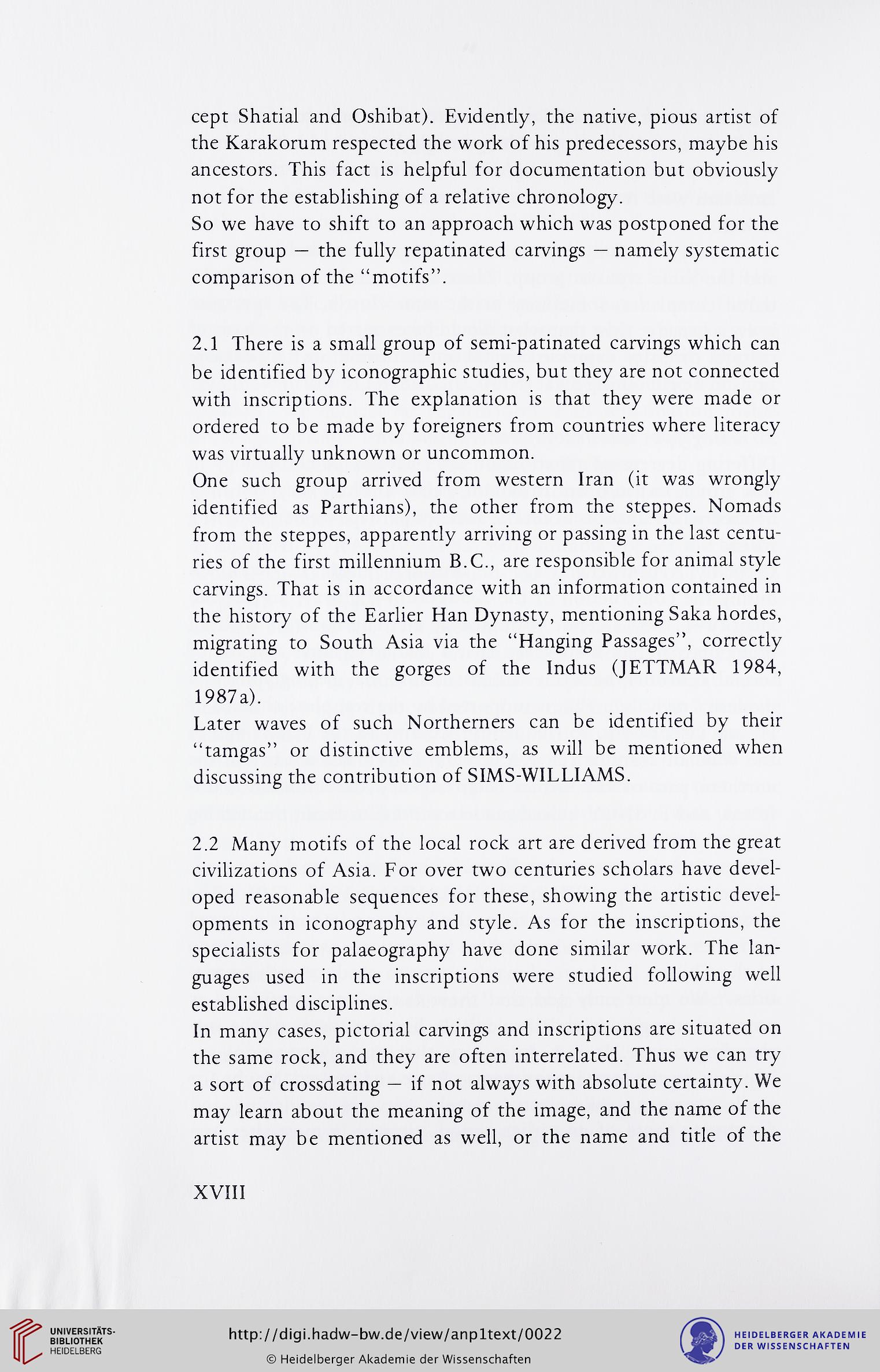cept Shatial and Oshibat). Evidently, the native, pious artist of
the Karakorum respected the work of his predecessors, maybe his
ancestors. This fact is helpful for documentation but obviously
not for the establishing of a relative chronology.
So we have to shift to an approach which was postponed for the
first group — the fully repatinated carvings — namely systematic
comparison of the "motifs".
2.1 There is a small group of semi-patinated carvings which can
be identified by iconographic studies, but they are not connected
with inscriptions. The explanation is that they were made or
ordered to be made by foreigners from countries where literacy
was virtually unknown or uncommon.
One such group arrived from western Iran (it was wrongly
identified as Parthians), the other from the steppes. Nomads
from the steppes, apparently arriving or passing in the last centu-
ries of the first millennium B.C., are responsible for animal style
carvings. That is in accordance with an information contained in
the history of the Earlier Han Dynasty, mentioning Saka hordes,
migrating to South Asia via the "Hanging Passages", correctly
identified with the gorges of the Indus (JETTMAR 1984,
1987a).
Later waves of such Northerners can be identified by their
"tamgas" or distinctive emblems, as will be mentioned when
discussing the contribution of SIMS-WILLIAMS.
2.2 Many motifs of the local rock art are derived from the great
civilizations of Asia. For over two centuries scholars have devel-
oped reasonable sequences for these, showing the artistic devel-
opments in iconography and style. As for the inscriptions, the
specialists for palaeography have done similar work. The lan-
guages used in the inscriptions were studied following well
established disciplines.
In many cases, pictorial carvings and inscriptions are situated on
the same rock, and they are often interrelated. Thus we can try
a sort of crossdating — if not always with absolute certainty. We
may learn about the meaning of the image, and the name of the
artist may be mentioned as well, or the name and title of the
XVIII
the Karakorum respected the work of his predecessors, maybe his
ancestors. This fact is helpful for documentation but obviously
not for the establishing of a relative chronology.
So we have to shift to an approach which was postponed for the
first group — the fully repatinated carvings — namely systematic
comparison of the "motifs".
2.1 There is a small group of semi-patinated carvings which can
be identified by iconographic studies, but they are not connected
with inscriptions. The explanation is that they were made or
ordered to be made by foreigners from countries where literacy
was virtually unknown or uncommon.
One such group arrived from western Iran (it was wrongly
identified as Parthians), the other from the steppes. Nomads
from the steppes, apparently arriving or passing in the last centu-
ries of the first millennium B.C., are responsible for animal style
carvings. That is in accordance with an information contained in
the history of the Earlier Han Dynasty, mentioning Saka hordes,
migrating to South Asia via the "Hanging Passages", correctly
identified with the gorges of the Indus (JETTMAR 1984,
1987a).
Later waves of such Northerners can be identified by their
"tamgas" or distinctive emblems, as will be mentioned when
discussing the contribution of SIMS-WILLIAMS.
2.2 Many motifs of the local rock art are derived from the great
civilizations of Asia. For over two centuries scholars have devel-
oped reasonable sequences for these, showing the artistic devel-
opments in iconography and style. As for the inscriptions, the
specialists for palaeography have done similar work. The lan-
guages used in the inscriptions were studied following well
established disciplines.
In many cases, pictorial carvings and inscriptions are situated on
the same rock, and they are often interrelated. Thus we can try
a sort of crossdating — if not always with absolute certainty. We
may learn about the meaning of the image, and the name of the
artist may be mentioned as well, or the name and title of the
XVIII




